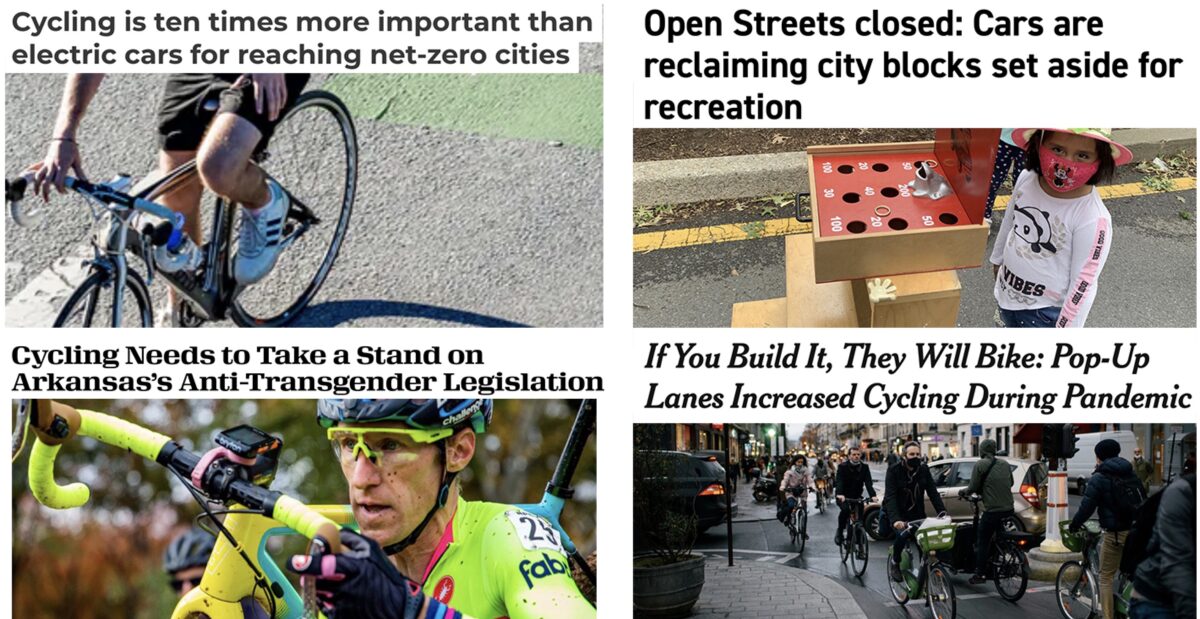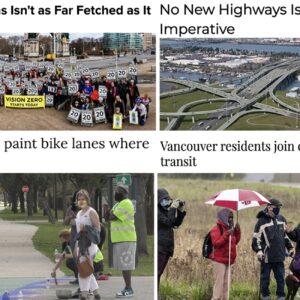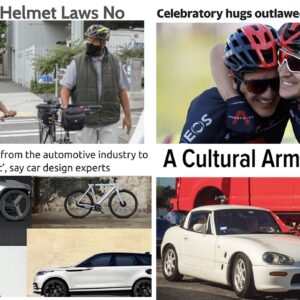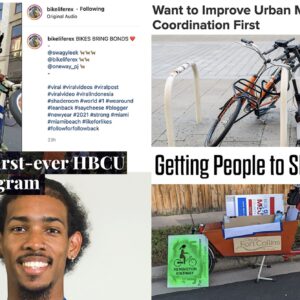Welcome to the week.
Here are the most notable items BikePortland editors and readers came across in the past seven days…
Stand up to hate: Portlander Molly Cameron is calling on the bike industry to stand against the hateful, anti-transgender laws in Arkansas that would prevent people from playing sports.
Build it and they will bike: One of the first peer-reviewed studies of the impact of new bike lanes installed due to the Covid bike boom found that in cities that added them, cycling increased 11 to 48 percent more than in cities that didn’t.
Get active, not electric: Switching to electric vehicles is important, but too much focus on electrification at the expense of bicycling will not get us to emissions goals fast enough.
Pandemic pilfering: NPR took a look at how bike theft is rising amid America’s bike boom and offered tips to prevent your bike from being stolen.
Advertisement
Transit greener than biking: New research into modal choice and carbon emissions took into account the vast positive environmental impact of biking and transit over driving and found that transit is greenest due to the manufacture and disposal of bicycles as well as the added calorie consumption required by their riders.
Remove highways, says White House: Freeway removal fans are feeling good with new US DOT Sec. Buttigieg at the helm and a new infrastructure proposal that prioritizes out the idea.
Keeping streets open: A cautionary tale from New York City where some of the streets opened to people during the pandemic have been re-claimed by car users.
Speed bumps for bikes: A cafe owner in Manhattan was so mad at the speed of e-bike riders they installed harsh speed bumps.
New rules of roads: Bloomberg’s list of five things that will make streets and cars less deadly is rightly focused on an overhaul of federal regulations.
Dark side of Walmart utopia: The Walton family’s efforts in making northwest Arkansas a cycling mecca have attracted a lot of excitement from bike lovers, but are folks who move and vacation there helping fuel something sinister?
Thanks to everyone who shared links with us this week! Tracking the best stories is a community effort and I am very grateful for your help.
— Jonathan Maus: (503) 706-8804, @jonathan_maus on Twitter and jonathan@bikeportland.org
— Get our headlines delivered to your inbox.
— Support this independent community media outlet with a one-time contribution or monthly subscription.







Thanks for reading.
BikePortland has served this community with independent community journalism since 2005. We rely on subscriptions from readers like you to survive. Your financial support is vital in keeping this valuable resource alive and well.
Please subscribe today to strengthen and expand our work.
Re: “Build it and they will bike” – what a shame that Portland is one of the cities that chose not to build any new bike lanes as a COVID response.
Yeah they didn’t do any bike lanes in direct response to Covid… But they have been pretty busy building permanent bike lanes. Seems to me in the past year they’ve announced completion/construction of a solid amount of really important bikeways/bike projects. I’m putting together a list FWIW and will share soon.
Quick note on the WSR article about the business that put speed bumps in the bike lane. Here is the street view of Amsterdam Ave, which has 5 lanes for cars (presumably one of those has seating). Clearly, a PBL AND safe outdoor restaurant space can and should be the priority. The restaurant manager has safety as his ultimate goal (most restaurant owners in the city know how important delivery bikers are to the restaurant economy).
I like speed bumps, and I can not lie..
I’ve found this claim to be a bit dubious. Most people aren’t getting enough exercise so the health benefits will likely outweigh any additional CO2 consumption from food. The implication seems to be we should all be living sedentary lifestyles to consume as little calories as possible. Also who’s to say drivers or transit riders don’t consume as many calories? If they’re living a similar healthy lifestyle as the cyclist they’re exercising and consuming those additional calories outside of their commute time.
Yeah, I get that they’re trying to be thorough and account for variables, but they seem to have missed the full picture.
If memory serves, the whole bike rider-consumes-more-than-your-SUV canard was based on a paper napkin calculation by a couple guys, probably drunk guys, who used fishy assumptions and edge cases to show that I am eating and turning into CO2 about a quarter tank equivalent of food every day. It always seemed bogus and I don’t believe it.
“based on a paper napkin calculation by a couple guys, probably drunk guys”
The drunk scribbling was performed by climate Scientist David Keith and research fellow David Thorpe.
David Keith is a highly-published Professor of Applied Physics at Harvard’s School of Engineering and Applied Sciences and Professor of Public Policy at the Harvard Kennedy School.
https://keith.seas.harvard.edu/blog/climate-impacts-biking-vs-driving
“fishy assumptions and edge cases”
The horror of using “edge cases” (e.g. the standard ‘merkin diet and wildly popular paleo/low-carb diets) to help people consider how dietary choices may impact active transportation-associated emissions.
Yup, the devil is in the details, and math doesn’t lie if those scientists were being honest, and I have no reason to think they weren’t.
The bike rider already has a bike so no need to extract and manufacture the metric ton of material it would take to make them a priusowner. Why these respectable sober people wrote this car commercial copy is beyond me.
CO2 output per marginal kilometer is a red herring. At 1:00 PM on a sunny Saturday your priusowner is about 10,000 times more likely to catch the sunset at the coast than in the before days when their bike was in use. A few trips like that and their annual CO2 output is off the chart.
‘It’s totally cool to go see my friend in Pendleton because Prius’
And again: paleo diet my ass.
“the health benefits will likely outweigh”
The idea that a large amount of exercise is necessarily has health benefits is speculative. If anything the epidemiological literature (sadly, the gold standard in this area) suggests that modest amounts of low-impact exercise (e.g. walking) confers much of the benefit/risk-reduction.
Biking is a low-impact exercise.
Me: “modest amounts of low-impact exercise (e.g. walking) confers…”
You: “Biking is a low-impact exercise.”
I hope you can move beyond defensiveness and acknowledge that there is no inconsistency here.
Who said anything about a large amount of exercise? The claim about increased caloric consumption doesn’t suggest any specific amount of exercise. The amount of exercise large or small is kind of moot when you’re talking about a populace that is obviously not exercising enough. Does your epidemiological literature have anything to say about no exercise vs any amount of exercise? Also I too find it odd that biking wouldn’t be considered low-impact.
Calories burned cycling: ~450-550 kcal/hour
According to BLS statistics, the average USAnian spends ~14 minutes a day “exercising” and a large chunk of this time includes walking to and from the SUV/monster-truck.
Calories burned walking to SUV/monster-truck: ~200-250 kcal/hour
Calories burned sitting in stationary or mobile couch: ~50-60 kcal/hour
https://www.washingtonpost.com/business/2019/10/30/actually-you-do-have-enough-time-exercise-heres-data-prove-it/
I always wondered about it when I commuted 14 miles from Hillsboro to Lake Oswego and was riding right next to hundreds of vehicle exhaust pipes. Is this doing more harm than good??
Yes, exactly. If they’re going to include food intake, them take the rest of the factors into account–increased energy consumption at health care facilities treating people for sedentary-lifestyle health problems, or who get hit by cars…
Or just go to another extreme–driving is greener because it kills so many people that it reduces life expectancy, meaning each person is consuming less because their average lifetimes are slightly shorter. It’s absurd, but not more than the calorie argument.
I find equally ridiculous any suggestion that bike manufacturing/disposal environmental impacts are not dwarfed by impacts for a light rail system or bus. A bike would be approximately equivalent to one seat on a train or bus (and much more recyclable), which itself is a very tiny fraction of the whole vehicle and then there are the impacts of track maintenance/road wear/etc.
Ironically, Jonathan’s Bloomberg piece link and the cited study suggest that the total lifecycle CO2e of cycling was lower than all other modes, except for e-cycling. (Wrong link?)
https://www.bloomberg.com/news/articles/2021-03-31/switching-from-cars-to-bikes-cuts-commuting-emissions-by-67
But it’s always interesting to see how bent out of shape some cycling fans get about any discussion of the very significant CO2e emissions associated with diet.
“Switching to electric vehicles is important, but too much focus on electrification at the expense of bicycling will not get us to emissions goals fast enough.”
I doubt cycling will play a major role in transportation decarbonization in the USA (or Portland) over the next nine years. The math just isn’t there. For example, cycling mode share in Portland has dropped steadily since 2014. Therefore, I can understand why many focus their attention on electrification even though they may understand that a concurrent shift to active transport would be optimal.
There is also a social justice argument for emphasizing pedestrian-transit infrastructure in the USA. Cities like Portland have racially and economically segregated black, indigenous, latine, immigrant and other marginalized communities to peripheral neighborhoods that lack basic transportation infrastructure. Sidewalks, transit, and access to subsidized EV-share are likely to be a more effective approach for decarbonization of outer ring neighborhoods (where trip distances make cycling especially unattractive).
“Transit greener than biking”
Hawthorne is a comp plan/TSP major transit route. The push back against rose lanes from PBOT is another example of how the city’s transportation and climate action goals are toilet paper (non-recycled and bleached).
Soren, can you link the research that shows “cycling mode share in Portland has dropped steadily since 2014.”
https://bikeportland.org/2020/09/29/census-portland-bike-commuting-laid-low-again-in-year-before-covid-321229
Note that my own analyses of normalized PBOT bike counts show a very similar decrease starting in 2014.
Thank you.
Thanks Soren. Note that this is an unprecedented drop. No other city has experienced a similar drop as far as I am aware. There may be some cohort effects (eg gas price, housing price, etc), but other cities such as NYC that have seen a continued rise also have one thing in common: building separated bike lanes. Build a separated and safe network, and watch modal share skyrocket. That is the most predictable indicator of modal share.
WalMart gutted the commercial district of every small town in the Midwest (I’m from there and I’ve seen the empty storefronts and brick-strewn vacant lots) while screwing down the wholesale prices they paid to suppliers like Vlasic Pickles until they squeaked or just quietly went bankrupt–all to fund a taxpayer financed managerial classy-topia?
NWA? Get Out!
Trying to chime in before any anti-trans haters get in here. I have read BP daily for 15 years, and I thank Jonathan for all that he does. He has a positive impact on our region, and I’m grateful. I also have a TON of respect for Molly/ her stances on policies.
I have witnessed both ignorant as well as intentionally hurtful comments in the comment section here on BP when Molly Cameron is mentioned. Please don’t allow those commenters to take over the thread. Molly is on the right side of history and we ALL should be standing with her.
We need to have some care and compassion with transgender and sports. It is not as simple as a right and wrong side. If not done properly trans’ rights might start to push against women’s rights, which nobody wants. Everybody can and should compete. There just needs to be some careful work done to determine what is fair from a competitive point of view.
Is it possible to have a different opinion on boycotting the events in Arkansas and not be considered anti-trans? Personal attacks are always wrong but isn’t respectful debate the very basis of free speech and democracy. Unless you are both willing to listen to opposing views and consider them, why would someone else bother listening to your views and considering them?
Thanks one. And no one has to worry about “anti-trans haters” posting here. I admit I let too many inappropriate comments through in the past, but it won’t happen again. I manually approve every single comment now and I have much lower tolerance for what constitutes a healthy debate and what is simply mean and not worthy of publication.
The Economist magazine has been very critical of allowing transgender athletes to compete in the protected space traditionally reserved for women. It sounds like you would not allow the editor of the Economist to comment on BikePortland.
Can that be called a fostering of healthy debate?
Hi BikeRound,
I’m a big fan of the Economist and have been a subscriber for years! This is a complex topic and I just want to be careful about the tone and nature of the discussion of it on here.
I don’t believe for a minute that the anti-trans laws in Arkansas or anywhere in the south exist for any reason than to harm trans people but I do think it’s a good moment to recognize that gendered sports are silly and should be done away with.
Let’s stop categorizing athletes based on their genitalia. Let them compete based on skills with whomever can keep up with them.
There would be no athletes besides xy athletes between the age of about 16 and 40 after a few years. Clara Honsinger is the best female cross racer in this country. She was 38th overall at an hour long mountain bike race this weekend in Corvallis (the Mudslinger). She beat the next best professional female racer by almost 5 minutes but she was also beaten by a 12 year old boy and 3 50+ year old men. There are gender differences in athletic performance. There needs to be a place for all to compete.
if I can find a group of people as slow as I am to compete with, that would be awesome. Cat 7 anyone?
Regarding green transit:
Most people already own a bike, but just rarely use it, and many may just use their existing bike if they started to bike commute. The author assumes everyone who would start bike commuting would need to purchase a bike. There is less additional carbon footprint in starting to use a bike someone already purchased in the past, but rarely used before, assuming it does not need too many parts replaced.
People who start to bike commute might be more likely to be doing it as part of an emphasis on better health, vs those who start to use transit. For that subgroup who may be making both exercise and diet improvements, there would likely be some average improvement in BMI, which would lower there over-all calorie intake. Most calories are consumed by the basal metabolic rate which will go down with BMI. This group might also start making healthier food choices, which can greatly lower carbon footprint per calorie.
Yeah, that study seems completely bogus. Your average Trimet bus weighs close to 40,000 lbs, meaning it is 2000x the weight of your average bicycle, plus it burns thousands of gallons of the most polluting diesel fuel. Show me how 2000 cyclists have a worse impact.
It is definitely bad for the individual NYC neighborhoods where Open Streets have been closed…
However…
The average car centric American has zero clue what they are missing until they experience it…
AND don’t appreciate it until it is taken away.
This could actually be very good for Open Streets on a state and local level in that A LOT more people actually care and will be complaining about it now.